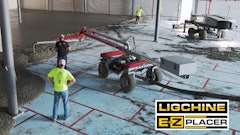
New construction is on the rise across the country — especially for multi-family residential units, where completions are at record numbers and show little evidence of slowing down into 2020.
Multi-family residential projects create an ideal environment for contractors looking to break into or grow their business in high-flow material markets with gypsum floor underlayment, grouting, cellular concrete, plaster and stucco applications.
However, success in this field requires an investment in specialized equipment — a limiting factor for many bottom-line-conscious contractors. While there is no way to offset equipment costs altogether, recent innovations in gypsum mixer/pumps have made these units more affordable, user-friendly and versatile than previous options. With the right equipment, contractors can see quick ROI and increased efficiency.
Here are several key factors to consider when selecting a gypsum mixer/pump to maximize productivity and profitability.
 While there is no way to offset equipment costs altogether, recent innovations in gypsum mixer/pumps have made these units more affordable, user-friendly and versatile than previous options. With the right equipment, contractors can see quick ROI and increased efficiency.Blastcrete
While there is no way to offset equipment costs altogether, recent innovations in gypsum mixer/pumps have made these units more affordable, user-friendly and versatile than previous options. With the right equipment, contractors can see quick ROI and increased efficiency.Blastcrete
Pump Type
The type of pump is perhaps the most important feature to consider when investing in a gypsum mixer/pump.
For contractors considering lower output gypsum applications such as radiant heat, smaller and more economical peristaltic/squeeze pumps can be used successfully. However, squeeze pumps will surge, which results in a light interruption in material flow. Minimal surging can lead to splatter on drywall, resulting in unnecessary cleanup. The squeeze pump has a maximum 450 psi line pressure which limits pumping distance to around 300 ft. (91 m).
Rotor-stator pumps, on the other hand, provide continuous flow, eliminating surges and increasing productivity. These pumps can generate up to 600 psi of pumping pressure — about 30% more than squeeze pumps — for pumping distances in excess of 150 ft. (46 m) vertically and 500 ft. (152 m) horizontally.
Recent advancements in rotor-stator technology led to the introduction of an adjustable rotor-stator pump with inline pressure gauge to the gypsum mixer/pump market. This innovation allows contractors to adjust flow to meet a project’s unique requirements. Tightening the rotor-stator results in maximum pumping distances, which is ideal for high-rise and long-distance jobs. When the job requires shorter pumping distances — between 200 and 300 ft. (61 to 91 m) — contractors simply loosen the rotor-stator. This flexibility results in optimum pumping pressure for the application.
Adjusting the pump to fit the application specifications results in less wear and tear on the rotor-stator, since these are the primary wear parts on this style of pump. Monitoring and adjusting the line pressure helps contractor double or even triple the life of these components.
To further minimize lifetime maintenance costs and unnecessary downtime, some OEMs design their adjustable rotor-stator pumps with easy access to mechanical seals. This user-friendly design allows operators to perform mechanical seal maintenance without dismantling the rotor and stator, drastically reducing labor expenses and saving hours of unnecessary downtime.
 As the gypsum industry continues to develop, more economical mixer/pump options with simpler and more user-friendly designs are filling the gap, offering contractors the ability to select equipment based on their needs without overinvesting.Blastcrete
As the gypsum industry continues to develop, more economical mixer/pump options with simpler and more user-friendly designs are filling the gap, offering contractors the ability to select equipment based on their needs without overinvesting.Blastcrete
Price Point
No product selection discussion would be complete without touching on price. Cost is an important factor in determining the value a piece of equipment brings to a business and whether it’s worth pursuing. In the past, a limited selection of gypsum mixer/pump models meant contractors looking to invest in gypsum equipment might be stuck with a higher price tag and unnecessary features for their operation. A lack of specialized gypsum equipment options also led some contractors to purchase units designed for more general cementitious applications — a situation that came with its own host of problems. However, as the gypsum industry continues to develop, more economical mixer/pump options with simpler and more user-friendly designs are filling the gap, offering contractors the ability to select equipment based on their needs without overinvesting.
Prices for a new gypsum mixer/pump can range from $45,000 to well over $125,000. Comparing apples to apples in terms of capacity and output, contractors will find minimal difference between most gypsum machines.
The industry average is 12-cubic-foot mixers and pumping speeds well over 100 bags of gypsum per hour. Differences arise with a closer inspection of the spec sheets. Contractors looking to not pay for more than they need should contact manufacturers to walk through what features are necessary for their specific operation.
For example, engine size can play a huge part in price differentiation. Gypsum mixer/pumps range in size from 3,350 lbs. (1,520 kg) with a 32-hp engine to nearly 10,000 lbs. (4,536 kgs) with a 100-hp engine. Exactly how much horsepower is necessary will depend on the target applications, so discussing options with OEM experts is important for making the most practical and economical decision. While gypsum mixer/pumps are not totally customizable, partnering with certain OEMs allows for a more personalized result, often with a significant cost savings over standard models.
 In addition to reducing the initial cost, selecting a reliable gypsum mixer/pump that does the basics and does them well often results in a user-friendly unit that’s easy to operate, maintain, and keep clean.Blastcrete
In addition to reducing the initial cost, selecting a reliable gypsum mixer/pump that does the basics and does them well often results in a user-friendly unit that’s easy to operate, maintain, and keep clean.Blastcrete
Simplified Design
The saying “less is more” often applies to gypsum mixer/pumps. In addition to reducing the initial cost, selecting a reliable gypsum mixer/pump that does the basics and does them well often results in a user-friendly unit that’s easy to operate, maintain, and keep clean.
To make the most of an equipment investment, the machine needs to have high utilization. For contractors looking to operate at multiple jobsites with multiple crews, selecting a gypsum mixer/pump with the essential components and no frills equates to less training, less downtime and less stress. Machines with a simple, intuitive design are easy to operate with minimal training. This opens up the door for maximum productivity since contractors can train several crew members and still deliver quality results.
Fewer moving parts also means less mess and less maintenance. A unit’s mixer is a good example of this. Most units feature either a paddle type mixer or a hydraulic spiral mixer. Both work quickly, mixing a full load in about two minutes. However, hydraulic spiral mixers offer a benefit over paddle mixers since they can operate at higher speeds without splashing or throwing material out of the mixer.
This leads to increased productivity since crews are not spending unnecessary time cleaning. Additionally, the paddle style mixers used in gypsum equipment usually have two mixer shafts, which doubles the moving parts. Compare this to a single planetary gearbox driving the spiral mixer. With features like spiral mixers, new gypsum mixer/pumps limit possible maintenance issues and unnecessary downtime by minimizing moving parts.
These time-savings aren’t limited to major maintenance. Proper cleaning is vital for any concrete pump, including gypsum equipment. The less there is to clean, the faster this process will be. Look for a model with easily accessible wear parts to make daily cleaning as efficient as possible. Some manufactures have gone a step further to simplify maintenance by engineering a removable mixer and pump kit that simply detaches from the machine for the ease of cleaning and scheduled maintenance.
 Units featuring robust trailers for long-distance travel and a lighter footprint provide a more practical solution for extended service areas.Blastcrete
Units featuring robust trailers for long-distance travel and a lighter footprint provide a more practical solution for extended service areas.Blastcrete
Maneuverability
Transportability is another key consideration when selecting the right mixer/pump combination. The larger and more remote the contractor’s service area, the more vital this becomes. Units featuring robust trailers for long-distance travel and a lighter footprint provide a more practical solution for extended service areas. For maximum maneuverability, look for a unit with a dual axle high-speed towing trailer and tubular steel frame to enable safe travel on highways.
Onsite maneuverability is another area to keep in mind. Once the equipment has arrived, its placement and use can be quite the logistical challenge — especially on crowded jobsites. A gypsum pump with a smaller footprint can increase overall productivity.
The charging process for different machines is a good example of this. Some models include a skip hoist to charge the mixer. The hoist is filled with sand and gypsum either by hand or with a skid-steer bucket. When full, it rises and dumps into the mixer.
This system requires sand and gypsum material to be stored near the pump and ample space for the hoist to maneuver, limiting where contractors can set it up. Gypsum pumps without the skip hoist eliminate the additional step and can be charged directly with a specially designed skid-steer bucket. This not only saves time and energy, it allows contractors to set up sand and gypsum stockpiles in a separate location when space is at a premium.
Customer Service
As with many equipment decisions, brand is an important factor to consider when selecting a gypsum mixer/pump. The right machine will ultimately be the one with the ideal combination of features and price, but the service and support behind that unit can’t be discounted. Partnering with a manufacturer that has a reputation for robust, high-quality machines means operators can expect fewer breakdowns over its lifetime. Plus, when parts and service are required, knowing the team behind the brand is available 24/7 can be a huge relief. From fast delivery of parts to expert troubleshooting, dedicated OEMs help their customers increase efficiency.
Making the Right Selection
The surest route to success in any business starts with investing in the best equipment to get the job done quickly and efficiently. Recent advances are making it easier and more economical for first-time and veteran gypsum contractors to take this step, but there are still many factors to consider. From design to durability, selecting a gypsum mixer/pump for maximum productivity and profitability must begin with the contractor’s unique needs.
About the Author
Tripp Farrell joined Blastcrete Equipment, LLC in 2000 and serves as president. In addition to his responsibilities in sales, he works in product design and conducts product demonstrations and training. He is also involved in advertising and marketing of the Blastcrete product line, as well as research and development and, most importantly, customer service. He can be reached at [email protected] or 800-235-4867.


























